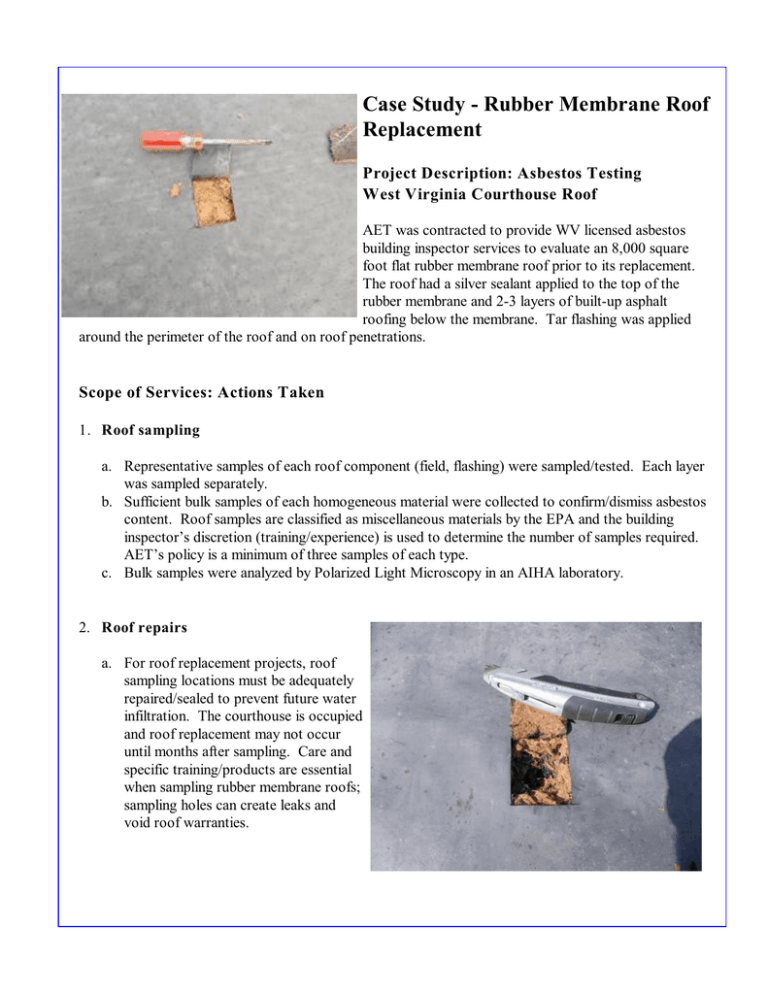Rubber Membrane Roof Replacement
advertisement

Case Study - Rubber Membrane Roof Replacement Project Description: Asbestos Testing West Virginia Courthouse Roof AET was contracted to provide WV licensed asbestos building inspector services to evaluate an 8,000 square foot flat rubber membrane roof prior to its replacement. The roof had a silver sealant applied to the top of the rubber membrane and 2-3 layers of built-up asphalt roofing below the membrane. Tar flashing was applied around the perimeter of the roof and on roof penetrations. Scope of Services: Actions Taken 1. Roof sampling a. Representative samples of each roof component (field, flashing) were sampled/tested. Each layer was sampled separately. b. Sufficient bulk samples of each homogeneous material were collected to confirm/dismiss asbestos content. Roof samples are classified as miscellaneous materials by the EPA and the building inspector’s discretion (training/experience) is used to determine the number of samples required. AET’s policy is a minimum of three samples of each type. c. Bulk samples were analyzed by Polarized Light Microscopy in an AIHA laboratory. 2. Roof repairs a. For roof replacement projects, roof sampling locations must be adequately repaired/sealed to prevent future water infiltration. The courthouse is occupied and roof replacement may not occur until months after sampling. Care and specific training/products are essential when sampling rubber membrane roofs; sampling holes can create leaks and void roof warranties. 3. Roof sampling process a. Roof sampling locations were chosen on all sections of the roof. Locations were high spots on each roof section where water was not pooling or accumulating. b. A razor knife was used to cut three sides of an approximate 3" square hole into the rubber membrane leaving a flap to cover over later. c. A hammer/chisel was used to collect a bulk sample of each separate layer below the membrane. Water was used to wet/control fiber release during sampling. Samples were placed in resealable plastic bags, uniquely numbered and submitted to the laboratory. Sampling continued down to the wood substrate at each location. d. Waste generated by bulk sampling was placed in a separate waste bag. Acetone was used to clean an approximate 1 square foot surface around the sampling hole. e. Weatherbond 710 corner covers (a 7" x 9" self adhesive patch) was installed over the sampling hole. f. DAP watertight asphalt sealant was used to seal the perimeter surfaces of the patch. Conclusion/Decision-Making AET’s Building Inspector determined that each roof section contained similar building components/materials. No differentiation in either visual assessment or sampling results could be determined. The entire roof was deemed to be asbestos containing and must be removed in accordance with West Virginia Asbestos Regulations. Note: The products or roof repairs detailed herein are to install a temporary patch prior to roof replacement. Consult a licensed roofer for specific means, methods and products to be used for roof repair not to void the roof warranty. When you need professional help or advice, email Alan Sutherland, CIH, CHMM at a.sutherland@aetinc.biz or call 610-891-0114. We provide nationwide services; phone consultations are free. Check out the full range of environmental contracting/consulting services we provide at our website www.aetinc.biz. Accredited Environmental Technologies, Inc.




